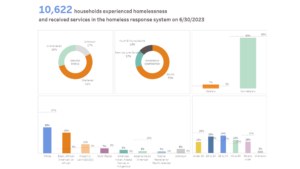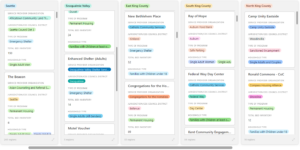Data and technology play a key role in addressing homelessness nationwide. One tool utilized is the Homeless Management Information System (HMIS), a secure online database used to collect client-level information about people experiencing homelessness, those at risk of experiencing homelessness, and other data points. In this Q&A, KCRHA Deputy Chief Community Impact Officer Janelle Rothfolk explains how HMIS is used in the homelessness response system.
What is HMIS?
Janelle Rothfolk: HMIS is used by local, state, and federally funded homelessness and housing service providers to collect and manage data gathered while providing housing assistance and other services to those at-risk or those already experiencing homelessness for all programs within our Continuum of Care (CoC). The King County CoC is comprised of both housing and shelter programs, as well as supportive services, outreach, day centers, coordinated entry, and other interventions within King County.
HMIS is a requirement of the U.S. Department of Housing and Urban Development (HUD) and establishes standardization for all CoCs across the United States in the way they collect and manage data for individuals and families experiencing homelessness. The HMIS is the primary information technology system used for reporting the number of people experiencing homelessness and other outcomes to HUD, the U.S. Department of Health and Human Services (HHS), and the U.S. Department of Veterans Affairs (VA).
Why do we need HMIS?
JR: The information collected in the HMIS is not only used to fulfill federal reporting obligations but is also critical for understanding and planning in the effort to solve homelessness in King County.
From a client perspective, it provides a way to coordinate care with across organizations, process Coordinated Entry housing referrals, and keep track of essential information. From a data perspective, this information allows for detailed analysis of how our homeless response system is working. Better data leads to better decision-making in funding, capacity and scale, outcomes, and answers other system-wide questions.
The local platform the information is stored on is called Clarity, which is a software product of the company Bitfocus.inc. Clarity is a fully functioning customer relationship management product and is dynamic, secure, and real time.
What type of information is collected?
JR: The information collected varies depending on the project type, funding and service provider preference, which you can view here in more detail. Nonprofit service providers collect demographic information, enrollment and exits from shelter and service programs and many other useful data points like housing status, contacts, and other assessments to match people to the right housing interventions. Clients always have the option to have their information entered anonymously and can revoke consent at any time.
How is information collected?
JR: The HMIS is an ever-evolving system that has continued to improve since 2004. The CoC and HMIS lead agency (KCRHA) recognize that collecting detailed information on people experiencing the trauma of poverty, displacement and homelessness is difficult. Individuals and families move around, people may have low trust in the system, and information may be incomplete. One of our primary goals is to look at how we can improve people’s interactions with nonprofit service providers, like a shelter provider, and make it as easy as possible to collect information so that we can do a better job as a system.
What are some of the challenges with HMIS?
JR: The data represents real people, and people are being asked detailed questions about their lives while they’re in crisis and seeking emergency services to survive. Trauma and crisis are complicated. People move around and data could be missing. To reiterate, our goal is always aimed at how we can improve people’s interactions with service providers and make it as easy as possible to collect information. For the service providers who are doing the data collection, it’s important to remember that they may have outdated hardware and technology, they may be understaffed, and they may have to perform dual data entry, meaning they must enter information in their organizations database as well as in the HMIS. This year our team will be exploring ways to ease this burden while still collecting real time information.
A systemic challenge is that HMIS data continues to be siloed from health care and behavioral health information and from other governmental services, which means that service providers do not have a comprehensive look at what a client has access to and what they need for treatment, health care, access to medical or financial benefits, or other service supports. Without comprehensive information in a centralized database, the burden falls on the individual to know and advocate for what services they need—but that’s a significant burden for people who are already in crisis and who may not know how to navigate government systems. That’s why we are always looking into ways to create better data integration across systems.
Lastly, we would like to improve transparency of the system, so we are looking at creating a way for clients to view and have limited editing options for their own information in the HMIS record.
How has HMIS changed over time?
JR: Since its creation, the HMIS has gone through many updates to improve the accuracy of the information gathered. Every year, HUD offers an open comment period where service providers, community members, and others can give feedback and input on how to improve the data collection methodologies. Most recently, data collection practices have moved toward being more client-centered and trauma-informed. System-level analysis and reporting has also been improved to better understand the characteristics and outcomes of those experiencing homelessness. HMIS was originally designed to measure performance program by program, but it has since evolved to measure performance at a system level.
To wrap up, HMIS is an essential database that supports better service delivery, and we expect that it will keep improving over time.



